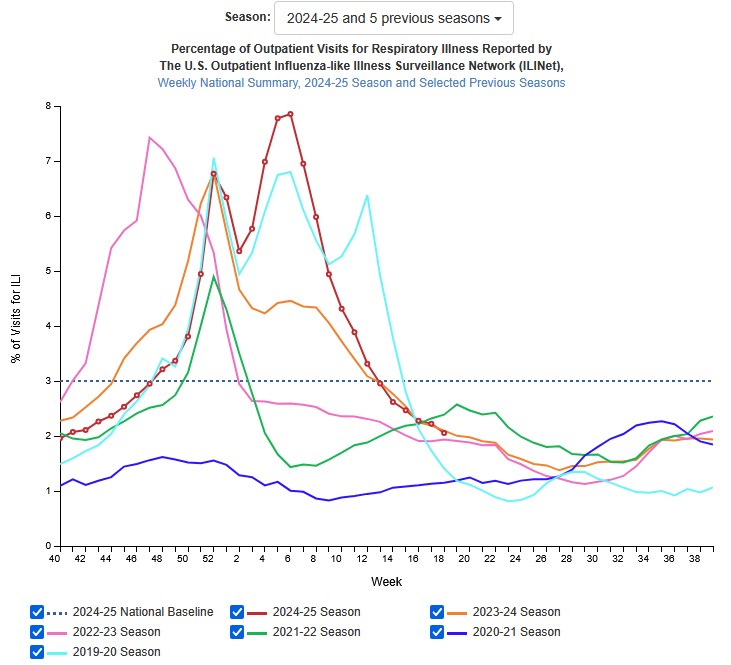A 2024-25 flu season that has been classified as high severity has now reached low transmission levels, but 10 new flu-related deaths in children bring the season’s total to 226, the most since 2009-10, when 288 pediatric deaths were recorded, according to the latest FluView update today from the Centers for Disease Control and Prevention (CDC).
The percentage of outpatient visits for influenza-like illness (ILI), or respiratory illness, dipped slightly from 2.2% the previous week to 2.1% last week (see CDC graph below). The number of patients hospitalized for flu dropped from 2,857 to 2,336. As with the previous week, no state reported moderate, high, or very high ILI activity.
Test positivity for flu has reached 3.6%, down from 4.6% the previous week. Hospitalizations and deaths are both down, but the cumulative hospitalization rate for this season—128.1 patients per 100,000 population—is the highest since the 2010-11 season.
The 10 newly confirmed pediatric deaths occurred from mid-January to mid-April. Seven of the new deaths in children were from influenza A and 3 from influenza B. Both deaths for which subtyping was performed were caused by the H3N2 strain. The CDC said, “Among children who were eligible for influenza vaccination and with known vaccine status, 90% of reported pediatric deaths have occurred in children who were not fully vaccinated against influenza.”
COVID-19, RSV activity stays low
Meanwhile, COVID-19 levels remain low, according to CDC data updates today. Wastewater detections last week remained generally low, except in Louisiana and South Dakata, which recorded high levels. The percentage of overall deaths caused by COVID last week stayed steady, at 0.6%, compared with 0.2% for flu.
The CDC’s biweekly variant proportion update shows a slight rise in the LP.8.1 subvariant, which now causes 70% of infections. The proportion of the XFC subvariant, which is the second most abundant, rose from 5% to 9%.
In its update on the three leading respiratory illnesses—flu, COVID-19, and respiratory syncytial virus (RSV)—the CDC notes that, nationally, flu (3.6%), COVID (2.9%), and RSV (1.2%) test positivity stayed about the same. Wastewater levels for COVID are low, while for influenza A and RSV they are very low.














